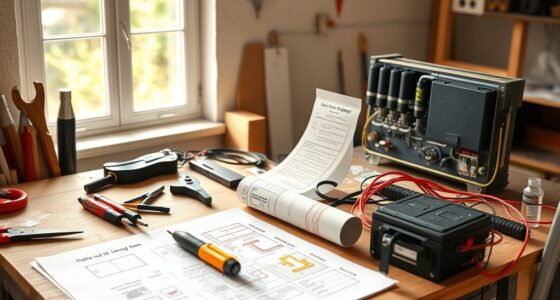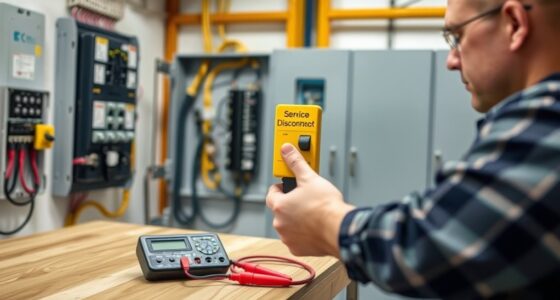If your oil pressure drops or rises unexpectedly, it can cause serious engine damage. Usually, low pressure means oil isn’t flowing properly, possibly from a leak, clogged filter, or worn components. High pressure might indicate a blocked passage or faulty sensor. Regular checks, maintaining oil levels, and addressing warning signs early are essential. To protect your engine, you’ll want to understand these faults better and learn how to handle them effectively.
Key Takeaways
- Proper oil pressure ensures engine lubrication, cooling, and protection against wear, preventing severe damage.
- Common causes of oil pressure faults include low oil levels, clogged filters, faulty sensors, and worn engine components.
- Warning signs include warning lights, engine knocking, overheating, and unusual gauge readings indicating pressure issues.
- Regular maintenance like oil level checks, filter replacement, and sensor calibration helps prevent pressure faults.
- Immediate professional diagnosis is essential to avoid engine damage when oil pressure warning lights or abnormal readings occur.
Understanding the Role of Oil Pressure in Your Engine
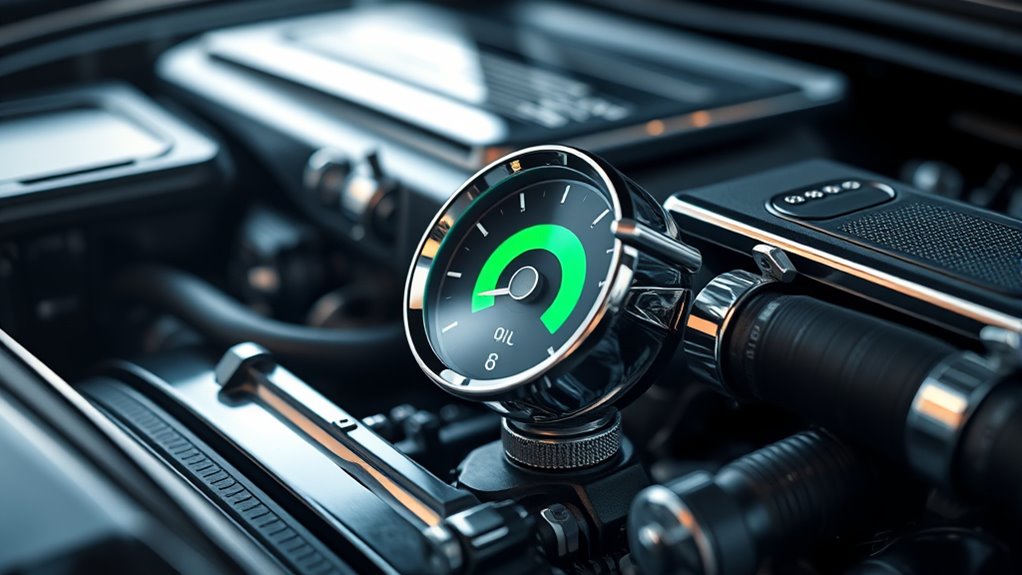
Oil pressure plays a crucial role in keeping your engine running smoothly by ensuring that oil reaches all moving parts. It creates a protective film that reduces friction and wear, helping components slide past each other efficiently. Proper oil pressure also carries heat away from engine parts, preventing overheating during operation. It pushes oil through passages, removing metal debris and impurities to maintain cleanliness. Additionally, it seals piston ring-cylinder gaps, improving compression and engine efficiency. Oil pressure maintains a fluid bearing effect in journals and bearings, preventing metal-to-metal contact and extending engine life. When your engine is cold, oil pressure is higher due to increased viscosity, but it drops as the engine warms. Maintaining the correct oil pressure ensures your engine stays protected and runs effectively. Monitoring oil pressure regularly is essential for early detection of potential issues that could lead to engine damage if left unaddressed. Regularly checking oil pressure levels can help identify problems before they cause significant engine damage.
Components That Impact Oil Pressure System Performance

Your engine’s oil pressure depends on several key components working correctly. If the oil pump isn’t efficient, or if the filter is clogged, pressure can drop or become inconsistent. Proper sensor placement also guarantees accurate readings, helping you catch issues before they cause damage. Maintaining these components regularly is essential to ensure the system functions optimally and prevents costly engine damage. Advances in machine learning algorithms can even assist in predicting potential failures in these components before they occur.
Oil Pump Efficiency
The efficiency of an oil pump hinges on several key components that directly influence the oil pressure system’s performance. Impellers or rotors create the vacuum needed to draw oil in, setting the flow rate. The drive gear or shaft transmits engine rotation to the pump, affecting speed and pressure output. The relief valve maintains a safe maximum pressure, preventing damage. The pump body and cover, made of durable metal, contain internal parts and withstand heat and pressure. Bearings and seals support shaft rotation and prevent leaks, ensuring consistent pressure. Different pump designs, like gear, gerotor, crescent, and rotor types, influence pressure and flow based on their construction. Proper pump size and speed are essential, as they directly impact oil delivery and pressure stability. Additionally, the internal components of the pump must be precisely manufactured and maintained to sustain optimal performance over time.
Oil Filter Condition
Ever wondered how the condition of your oil filter impacts overall oil pressure? If you use the wrong filter, it may not seal properly, causing leaks and pressure drops. Modern engines require filters that match their design to prevent unfiltered debris circulation, which can damage internal parts. The bypass valve inside the filter opens if the filter is clogged; if set too low or high, it can cause unfiltered oil flow or pressure issues. Over time, filters become clogged, increasing resistance and lowering pressure, risking engine damage. Using the correct size and high-quality filter media guarantees ideal flow and filtration. Regularly changing your filter prevents clogging, maintains consistent oil pressure, and protects your engine from wear and overheating. Additionally, a proper filter helps maintain the integrity of the oil pressure system, ensuring all components function correctly. Proper maintenance of the gumball machines and their components is crucial for optimal performance, much like ensuring your engine’s parts are in good condition.
Sensor Placement Accuracy
Proper sensor placement directly influences the accuracy of oil pressure readings, which in turn affects engine performance and maintenance decisions. When installed correctly, the sensor’s diaphragm is exposed to true oil pressure, preventing False readings or delays. Misplaced sensors can encounter unstable pressure or vibration, reducing reliability and lifespan. Placing sensors near the oil pump line improves responsiveness, allowing the ECU to react swiftly. Proper location also minimizes air bubbles and contaminants that can distort signals. Additionally, easy access for testing and replacement enhances maintenance efficiency. Ensuring the sensor’s environment is free from vibrations and contaminants is crucial for consistent performance.
How Oil Pressure Is Measured and Why It Matters
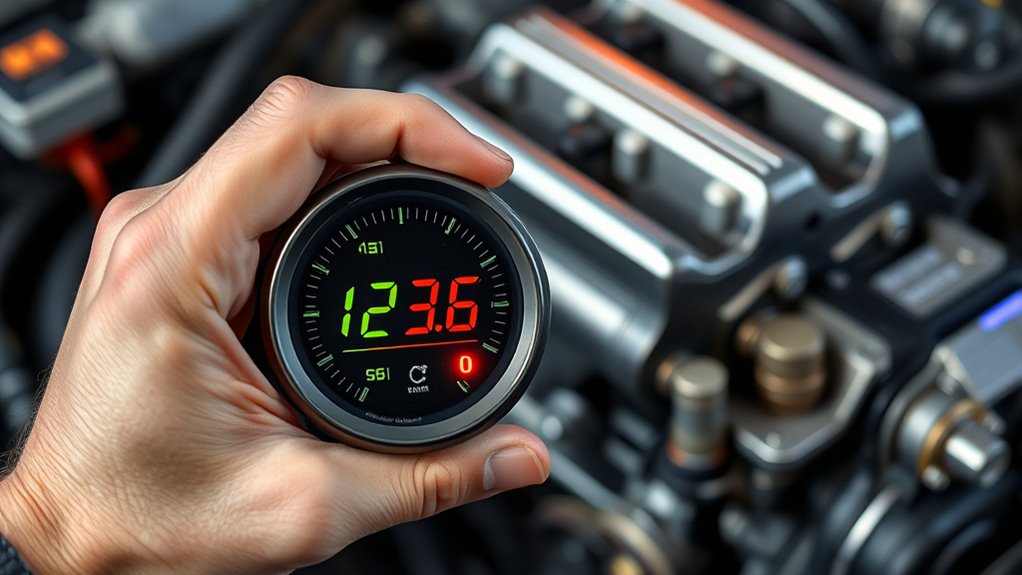
Understanding how oil pressure is measured is key to diagnosing engine issues, as sensors are placed in critical locations like near the oil filter or cylinder head. These sensors use different techniques, such as mechanical or electronic methods, to provide accurate readings. Monitoring oil pressure helps you spot problems early and keeps your engine running smoothly. A proper understanding of refrigeration cycle principles also ensures that the measurements reflect true engine conditions, especially when diagnosing issues related to oil flow and lubrication. Accurate measurement of oil pressure also relies on the proper calibration and installation of gauges, ensuring that the readings reflect true engine conditions.
Sensor Placement Significance
The placement of oil pressure sensors is critical because it directly impacts the accuracy of the pressure readings you rely on to assess engine health. Sensors are typically installed near the oil filter or on the cylinder block close to the filter housing, measuring pressure after the pump but before the sump. Proper positioning ensures readings reflect the oil leaving the pump, avoiding false low-pressure signals from return lines or the sump. If placed too far downstream, readings may decline as the engine warms, misleading diagnostics. Correct placement allows the ECU to respond accurately during low oil pressure events, activating warning lights or adjusting engine performance to safeguard essential components. Poor placement or faulty sensors can cause false alarms or missed warnings, risking damage and complicating maintenance. Incorrect placement can also lead to inaccurate sensor readings, which may result in unnecessary repairs or overlooked engine issues. Additionally, understanding sensor placement significance helps in diagnosing potential faults and ensuring the longevity of engine components.
Measurement Techniques Explained
Measuring oil pressure accurately is essential for evaluating engine health and preventing damage. There are various devices used, including mechanical gauges with a Bourdon tube or diaphragm, and digital gauges that use electronic sensors for precise readings. Mechanical gauges connect via a tube filled with oil, moving a needle to indicate pressure without needing electrical power, making them durable in tough environments. Electronic gauges convert pressure changes into electrical signals, providing real-time data on digital displays, ideal for modern vehicles. Measurement units like psi or bars help interpret readings—normal ranges typically fall between 20 and 65 psi. Low pressure suggests issues like leaks or pump failure, while high pressure could point to regulator problems or blockages. Proper calibration ensures that readings remain accurate over time, which is crucial for reliable diagnostics. Additionally, regular maintenance of measurement devices helps sustain their accuracy and prolongs their lifespan. Accurate measurement techniques are vital for early diagnosis and maintaining engine longevity.
Pressure Monitoring Importance
Have you ever considered how essential oil pressure is to your engine’s health? Monitoring it protects your engine from damage like bearing wear and failure. Oil pressure sensors alert you to dangerously low pressure, helping you act before costly repairs happen. These sensors provide real-time data to your dashboard and engine control module, enabling immediate responses. Proper oil pressure assures all moving parts stay lubricated, reducing friction and wear. If pressure drops, warning lights alert you instantly, minimizing risks of catastrophic failure. The oil pressure sensor plays a crucial role in maintaining optimal engine performance and preventing breakdowns, especially during demanding driving conditions. Regularly checking and understanding oil pressure readings helps ensure your engine remains in peak condition. Use this table to understand its importance:
| Aspect | Benefit |
|---|---|
| Real-time monitoring | Prevents unnoticed damage |
| Engine protection | Extends engine lifespan |
| Efficiency and safety | Enhances performance and reduces breakdowns |
Recognizing Signs of Low or High Oil Pressure

Recognizing signs of low or high oil pressure is essential for maintaining your engine’s health. Your dashboard warning light is the first alert, often activating before other issues appear. If the oil-pressure gauge drops outside the normal range, it indicates abnormal pressure levels. You might also hear engine noises like knocking, grinding, or ticking, which suggest poor lubrication. A whining sound can mean oil isn’t flowing properly through bearings, while metal-on-metal noises point to severe damage. Burning oil smells, visible leaks, or smoke from the exhaust signal oil burning or leaks. Additionally, you may notice decreased engine power, rough idling, or overheating, all tied to pressure problems. Recognizing these signs early helps prevent extensive engine damage and prompts timely inspections. The oil warning light or pressure gauge can sometimes give false readings if faulty, so always verify with a physical check of the oil level and condition. Increasing use of advanced sensors and diagnostics in modern vehicles aims to provide more accurate detection of pressure issues.
Common Causes of Oil Pressure Faults

Many oil pressure faults stem from straightforward issues like low oil levels or improper oil viscosity, which can disrupt the flow and pressure within your engine. Low oil levels often result from leaks, evaporation, or burning oil, causing the oil pump to draw in air and reduce lubrication. If the oil isn’t the correct viscosity, it may flow too easily or too slowly, affecting pressure and lubrication efficiency. Worn engine bearings or internal engine wear can increase clearances, allowing oil to leak and pressure to drop. A faulty or clogged oil pump or dirty oil filter can also restrict flow, leading to pressure faults. Regularly check your oil level, use the recommended oil, and inspect for leaks or pump issues to prevent these common causes. Additionally, regional statistics can influence the frequency and causes of oil pressure faults, emphasizing the importance of local knowledge in troubleshooting.
The Importance of Regular Oil Maintenance
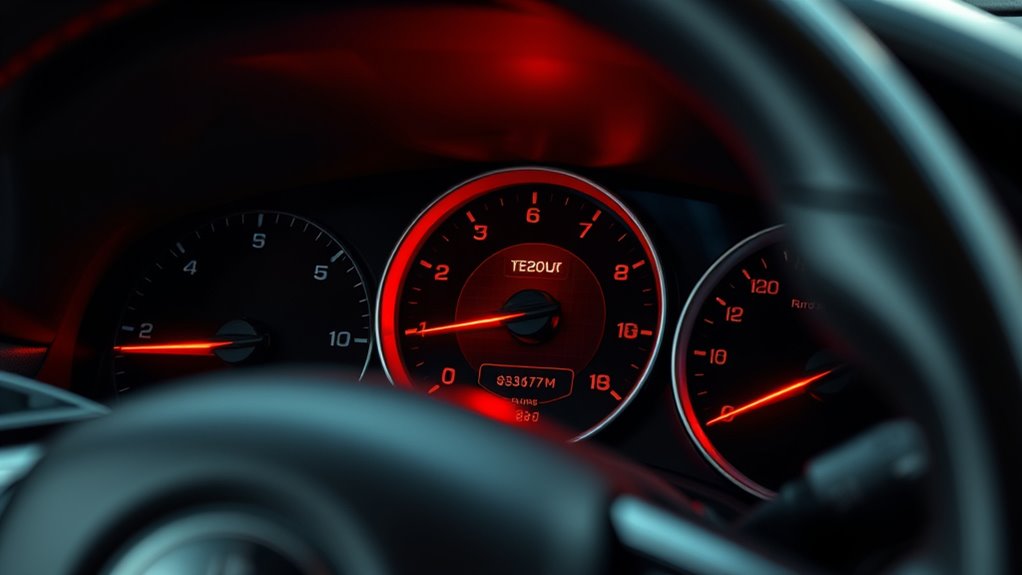
Regular oil maintenance is essential for keeping your engine running smoothly and preventing costly damage. Fresh motor oil lubricates engine parts, reducing friction, wear, and heat. Over time, oil degrades and loses its effectiveness, increasing mechanical stress on components like bearings and pistons. Regular oil changes restore lubrication, protecting your engine from premature damage. Maintaining clean oil also helps remove dirt, metal particles, and combustion by-products, preventing sludge buildup. Proper oil care ensures ideal temperature regulation, reducing overheating risks. When you skip maintenance, you risk accelerated wear, higher fuel consumption, and potential engine failure. Regular oil changes are a cost-effective way to extend engine life and improve performance. Here’s a quick overview:
| Benefit | How It Helps | Why It Matters |
|---|---|---|
| Engine Wear Prevention | Fresh oil reduces metal-on-metal contact | Saves costly repairs |
| Temperature Regulation | Maintains cooling efficiency | Prevents overheating |
| Contaminant Removal | Clears dirt and debris | Keeps engine clean and smooth |
| Fuel Efficiency | Reduces internal friction | Saves money at the pump |
Additionally, engine components rely heavily on proper lubrication to function optimally.
Troubleshooting Oil Pressure Issues
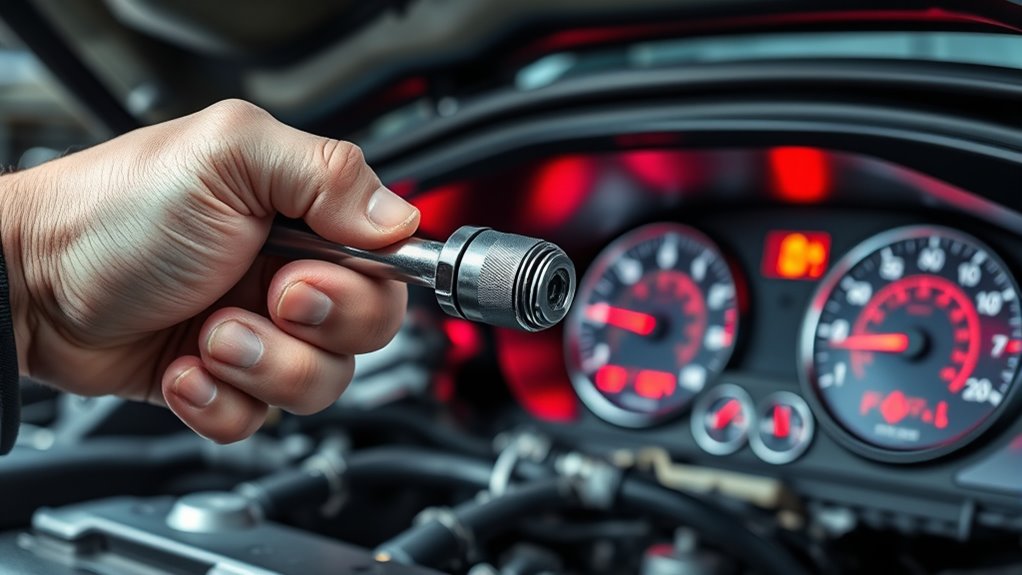
Troubleshooting oil pressure issues begins with a systematic inspection of key components that influence oil flow and measurement. Start by checking the oil level with the dipstick—low levels cause immediate pressure drops, while overfilling can also disrupt readings. Look at the oil’s color and cleanliness; dirty oil can clog the system, reducing pressure. Ensure you’re using the correct viscosity oil recommended by the manufacturer. Next, examine the oil filter for clogs or damage; a clogged filter restricts flow and lowers pressure. Inspect the oil pump and pickup screen for debris or blockages that impede circulation. Additionally, verify the condition of engine bearings, which wear over time and can lead to low pressure. Proper oil maintenance is essential for preventing pressure issues. Finally, test the oil pressure sensor and relief valve, as faults here can give false readings or cause actual pressure drops. Regular maintenance and inspections help identify potential issues early and prevent further damage.
When to Seek Professional Help

Recognizing when to seek professional help is essential for addressing oil pressure faults effectively. If your oil warning light comes on, or if your engine runs hotter than normal combined with a pressure drop, you should get expert diagnosis. A noticeably louder engine noise or a persistent oil pressure gauge reading near zero PSI after startup are critical signs that need immediate attention. Sludge buildup causing clogged passages also requires professional cleaning. Avoid attempting complex repairs like oil pump replacement or engine overhaul yourself, especially if you lack the proper tools or knowledge. Persistent sensor faults or internal engine wear indicators demand trained mechanics. Additionally, oil flow issues such as restricted passages or faulty sensors can contribute to inaccurate readings and should be diagnosed by professionals. Delaying professional help risks severe engine damage, costly repairs, or complete engine failure. Trust professionals to accurately diagnose and resolve serious oil pressure issues.
Frequently Asked Questions
How Does Oil Viscosity Affect Oil Pressure Readings?
Oil viscosity directly impacts your oil pressure readings because thicker oil resists flow more, resulting in higher pressure. Conversely, thinner oil flows easily, leading to lower pressure readings. Changes in temperature also affect viscosity, which in turn influences pressure. Using oil outside the recommended viscosity range can cause false readings, increased engine wear, or damage. Always select the right viscosity to maintain accurate pressure readings and guarantee proper engine lubrication.
Can a Faulty Oil Pressure Sensor Cause Warning Lights?
A faulty oil pressure sensor can definitely cause warning lights to come on, even if your oil level and pressure are fine. Remember, “looks can be deceiving,” so a malfunctioning sensor might flicker or stay on, misleading you into thinking there’s a real problem. If you see this, have the sensor checked and replaced if needed. Ignoring it could lead to unnecessary worries or overlooked engine issues.
What Is the Typical Lifespan of an Oil Pressure Sensor?
You can expect a mechanical oil pressure sensor to last up to 10 years, while electronic ones usually last around 5 years. The lifespan depends on the sensor’s quality, operating conditions, and maintenance. Harsh environments or poor upkeep can shorten this period. Regular oil changes, keeping the engine clean, and addressing issues promptly can help extend your sensor’s life, preventing costly repairs and engine damage.
How Do Temperature Changes Influence Oil Pressure Levels?
As temperatures dance up and down, they gently sway your oil pressure. When it’s cold, thick oil resists flow, raising pressure, but delays lubrication. As it warms, oil thins, lowering pressure but improving circulation. Too hot, and oil can become too thin, risking protection. Using the right oil, especially synthetic, helps keep these fluctuations smooth, ensuring your engine stays well-lubricated across all temperature swings.
Are Aftermarket Oil Pressure Gauges Reliable for Monitoring?
You can rely on aftermarket oil pressure gauges for monitoring, but their accuracy depends on quality and proper calibration. Mechanical gauges are highly dependable since they measure pressure directly, while electric ones are easier to install and offer real-time readings. However, watch out for wiring issues, calibration drift, or faulty sensors, which can cause inaccurate readings. Regular checks and calibration help guarantee your gauge provides trustworthy data during engine operation.
Conclusion
Remember, your engine’s oil pressure is the heartbeat that keeps it alive. If you ignore the warning signs, you risk knocking your engine’s life out of sync. Regular maintenance and attentive care are your tools to keep this essential rhythm steady. Think of it as tuning a delicate instrument—when you stay proactive, your engine sings smoothly, avoiding costly breakdowns. Keep a watchful eye, and your engine will thank you with reliable performance mile after mile.



